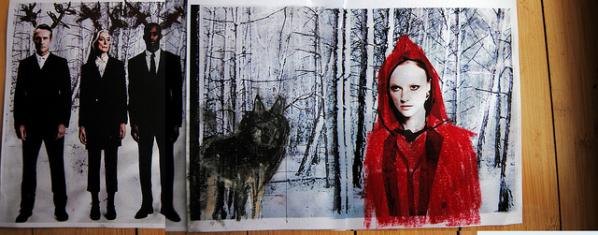



12 Remixes, by Michael Szpakowski
From August 2011 to July 2012, the video artist and musician Michael Szpakowski entered a remix competition every month, and compiled his remixes (some of them with accompanying videos) on his website. “I’m 54 years old,” he explained at the beginning of the project, “and although I’m musically reasonably deft I know little about the culture in which I’m attempting to intervene. I know none of the specialised vocabulary, can’t distinguish genres and although I understand what is being said, just about, I don’t speak the language in which posts or comments on this kind of work are framed.” The project, in other words, was a deliberate step outside his “comfort zone”.
The results are often startling. It’s worth comparing the remixes with the original tracks from which they derive, because it provides some insight into Szpakowski’s working methods, and makes you realise the extent of some of the transformations he has achieved.
One of the most striking examples is the remix of “Sandwiches” by the Detroit Grand Pubahs. The original track is a grotesquely overstated hyper-lecherous rap. A synthesised-drum-and-bass arrangement underpins a chipmunk-style speeded-up vocal, warbling lyrics of such obvious symbolism that they hardly qualify as suggestive: “I know you wanna do it/You know I wanna do it too/Out here on the danceflo’/We can make sandwiches…/You can be the bun/And I’ll be the burger, girl…/Make your thighs like butter: easily spread…” The effect is quirky, irritating and compulsive; tongue-in-cheek, deliberately outrageous, blatantly sexist and borderline pervy all at the same time.
Szpakowski’s remix has an entirely different feel. The vocals have been slowed right down from warbly chipmunk to entombed Darth Vader; correspondingly, the bassline has slowed too, from a prefabricated booty-shaker to something subterranean and slightly menacing; and in the space above there are echoey keyboard-notes floating and pulsing like luminous jellyfish. The effect of the lyrics is no longer leeringly voracious, but mournful, obsessive and introspective. There is an instrumental coda with a vaguely Scottish Highlands flavour to it. The feel of the track has changed completely, and so have its texture and geometry. We find ourselves in a darker, much larger space.

Another good example is “OK good stand clear”, based on “110%” by Laura Vane and the Vipertones. The original song is efficient, well-assembled funk/soul, complete with a punchy horn section and a sassy female lead vocal. It’s slick, sharp and professional, but hard-working rather than inspired. Szpakowski’s remix dispenses with almost everything except the rhythm section, which is slowed down slightly to give it more depth and a thumping creaky quality like an elephant in new walking-boots. To this he adds a sampled American voice saying “OK? Good” and “Stand clear of the closing doors!”, and a hammering piano-figure. Again the effect is to open the track out, to give it a more three-dimensional feel, and also to make it much less derivative, much less obviously the product of a particular genre.
In almost every instance Szpakowski’s remixes have a more resonant and spacious feel than the originals; the sounds are dirtier, fuzzier, more textured; and the rhythms are more complex. These changes may not always be entirely to his advantage. As he admits himself, “I don’t dance (or haven’t for twenty years or so), which actually makes a big difference in how one experiences popular music…” Certainly there is one track – a remix of “Paradisco” by Charlotte Gainsbourg and Beck – where Szpakowski’s version has a spiky, angular, echoey jazz feel, but loses out to the original in terms of finger-clicking compulsiveness. It’s true that his remix puts a stronger focus on Gainsbourg’s voice and lyrics than does the original; but whereas Gainsbourg and Beck’s version stays within the disco format and gives it an iconoclastic indie makeover, Szpakowski’s remix takes us beyond that format altogether, and comments on it from the outside.

In some of the tracks there is a move from the USA to Europe in terms of feel. One example is the remix of “What happens in Vegas” by Chuckie ft. Gregor Salto – a histrionic slab of USA club music. Szpakowki’s version (“Shit happens in Vegas”) has a distinctly Kraftwerk-esque, European-techno slant. Also, because the remixes are often crackly, fizzy and hissy, they tend to feel “older” than the originals. At times we seem to be listening to badly-tuned radios in the pre-digital era, or to vinyl LPs smothered in dirt and played through a fluff-laden needle. But this “distressed finish” effect is in keeping with a broader sense that Szpakowki’s remixing technique involves a kind of deconstruction or breaking-apart of the tracks on which he is working. They become less smooth and shiny, less self-contained. The original tracks are often tightly-focussed in terms of their musical styles, with a narrow range of subject-matter, and often with manipulative designs on the audience – wanting to make them feel like dancing, wanting to make them feel sexed-up, or trying to tug at their heart-strings (“Try to Stay Awake” by Frank Friend, “Trojans” by Atlas Genius and “Jigsaw” by Mimi Page are all relationship-based heartstring-tuggers). The remixes, on the other hand, aren’t looking for such straightforward reactions. Their subject-matter is less easy to pin down, and their ingredients bespeak a mixing-together of disparate materials, different cultures, and even different eras.
Non-musical ingredients are one noteworthy feature. In “OK good stand clear”, the voice saying “Stand clear of the closing doors!” comes, as Szpakowki explains, from “New York subway recorded announcements… grabbed, I think, from YouTube”. He is also fond of introducing a voice intoning random numbers – this occurs in several of the tracks. Usually the voice has a foreign accent, and sometimes the numbers are spoken in a foreign language. These number-sequences, says Szpakowski, come from “the so called ‘numbers stations’ which are believed to have been used by various intelligence agencies… they’re available at the internet archive“.
On “I’m getting a cat” the words come from mashed-up Tweets which have been run through a voice-to-text synthesiser. “I am that I am” borrows its vocal from the painter and sound poet Brion Gysin – a voice-sample which, until it begins to distort, sounds rather like a 1950s announcement on the BBC. “Speaking in Tongues” reverses the vocal on a hectoring soul track by Colonel Red called “Rain a Fall”, so that it ends up sounding as if it’s in some unspecified European or possibly Middle Eastern language. And “Sugar Plum Fairy on the Dancefloor” introduces the chiming melody from Tchaikovsky’s Sugar Plum Fairy into a rap called “Disco Technic” by Stan Smith, to surprisingly good effect. There is a genre-busting transgression of boundaries, a throwing-together of cultures, a jumbling-up of eras, and a deliberate use of incongruous material.

The videos Szpakowski has produced to accompany some of these tracks show similar traits. Again his admission that he doesn’t dance is relevant here, because the starting-point for many music videos – a very tight and emphatic synchronisation of visual effects with the beat of the track – is not a particularly dominant feature in his work. The one which succeeds best in this respect is the video for “OK good stand clear”, which projects text versions of the words onto the screen in big letters precisely as we hear them. There is also a lovely moment in the video for “I’m getting a cat” where, in a bit of old black-and-white footage, some youngsters sitting on chairs on a stage start to sway from side to side, apparently in time to the music.
But synchronisation to the beat isn’t Szpakowski’s priority. “I’m getting a cat” provides a good example of the kind of effect he achieves instead. The synthesised vocal for the track first announces that it’s getting a cat, then starts to ask absurd questions about cats and cat-care – “Does your cat try to style your hair?”; “What is your funniest and yet painful cat story?” – which are gradually infiltrated, first by other subject-matter – “Become a big brand on Facebook!” – then by symbols – “Poundsign poundsign poundsign” – and sequences of numbers. What starts off as funny, ironic and nostalgic develops or breaks down into a kind of digital fragmentation, and eventually into wordlessness. The end of the track is a wistful instrumental coda, embellished with piano and strings. And the video follows much the same path. It starts with old footage from the 1960s White House, in which President Lyndon B Johnson seems to be announcing his intention to get a cat to his slightly-bemused aides. Then there are some outtakes from what seems to be an instructional video in which a troubled youngster is being given helpful advice (presumably cat-care advice) by a reassuring and helpful older man. By the end of the track – the coda – we are watching teenagers playing music, drinking coffee and dancing. Again, humour and irony have been replaced by something more wistful and hard-to-define.
“Found” materials, often quite disparate materials spliced together by digital means, are just as important to the videos as they are to the remixes: they feature archive footage of the Whitehouse; shots of groovy teenagers from the Fifties or Sixties; Japanese Noh theatre; imagery based on Little Red Riding-Hood; square-dancing American kids; old claymation footage of teeth wearing boxing gloves; big black lettering; jumbles of coloured pixels; and images of Las Vegas captured from Google Maps, reconstituted into a long sun-baked backwards drive from the middle of town into the desert. Like the musical tracks they accompany, these videos cull their materials from many disparate places; they are full of little jolts of incongruity, slightly-bizarre juxtapositions; they lead us not only inwards towards the music but outwards towards different cultures and different eras; and they also call our attention to the digital medium itself, the Web on which all these materials are available, and the computer software which slices and splices them.

Perhaps most remix artists are more influenced by the work of their immediate peers than by art theory, art history, or inspiration drawn from other cultures. Not so with Szpakowski. As mentioned before, one of these remixes (“I am that I am”) uses a vocal track from Brion Gysin; and the words “OK good”, from “OK good stand clear”, are sampled from a recorded talk by William Burroughs. Burroughs and Gysin were the first proponents of cut-up and fold-up techniques in literature: Gysin was also an experimental painter and sound artist. This link with the two of them hints at a connection between Szpakowki’s remix style and modernist or post-modernist art. Remix culture itself is closely related to mash-ups, which in turn (whether remix artists are aware of it or not) can trace their ancestry not only to cut-ups and fold-ups but to the collages, bricolage, decalcomania and other mixed-media, mixed-genre experiments of the Modernists: experiments which reflected not only an urge on the part of Modernist artists to break free from received genres and formal conventions, but a feeling that the modern mind did not belong to a single era, a single unified body of belief or a single point of view – instead it contained many disparate perspectives, and ideas or images from many different eras and cultures, all thrown together into a jumble. For the modernists, this jumble was itself both one of the joys and one of the symptoms of modernity.
For modernist and post-modernist artists, formal perfection is often a secondary consideration, compared with the excitement of putting things together in new ways, seeing things from new angles. T S Eliot (in “Tradition and the Individual Talent”) described the mind of the artist as a “medium…in which special, or very varied, feelings are at liberty to enter into new combinations”. He made the same point in “The Metaphysical Poets”: the artist, he argues, “is constantly amalagamating disparate experience”; and modern art is bound to be more complicated than the art of earlier centuries, because modern life itself has become more complicated: “Our civilization comprehends great variety and complexity, and this variety and complexity… must produce various and complex results.” It was also argued, by various theorists, that modern artists found it increasingly difficult to belong wholeheartedly to a particular tradition, or to stick to a particular working method or lexicon of forms, because mass reproduction had made so many different traditions and examples, from so many different eras and cultures, available to them. If these observations were true at the beginning of the twentieth century, they are most certainly true now, at the beginning of the twenty-first, when life is characterised not just by “variety and complexity”, but by information-overload, and when the work of other artists, other eras and other traditions is available not only in museums, libraries, books and prints, but online at the click of a mouse or the blink of a Google query-screen. So one way of understanding Szpakowski’s remixes – his particular take on what a remix ought to be like – is to look at them in the light of modernist, post-modernist and digital-modernist aesthetics.
Another neo-modernist aspect of these remixes is their reluctance to woo the audience. There are moments when the arrangements are slightly unsympathetic to the listener. One example of this is “I’m getting a cat”, where the voice-over stops asking absurd questions about cat-care and starts coming out with fragmentary nonsense about Facebook, number-sequences, and “poundsign poundsign poundsign” instead. The “poundsign poundsign poundsign” sequence, in particular, goes on to a point where a lot of listeners might find themselves wishing it would stop. Similarly, on “I am that I am”, the voice-over, which starts with a sequence of variations on the theme of identity –
I AM THAT I AM
AM I THAT I AM
I THAT AM I AM
THAT I AM I AM
AM THAT I I AM
– soon gets speeded-up and distorted into an incomprehensible babble, and this babble is so loud and frenetic that it’s quite hard to hear the music. Again, some listeners may find themselves wishing that the voice-over would stop.
As already mentioned, the vocal track in “I am that I am” is based on an original piece by Brion Gysin, and Szpakowski has actually cut it down in order to re-use it – so although Szpakowski’s track may seem a little bit tough on the audience, it’s actually quite a bit less demanding than Gysin’s original. But the link with Gysin provides a clue to the aesthetics which are apparent throughout the whole “12 Remixes” project. “I am that I am”, as a text, is based on the idea of reordering a five-word line into all its possible variations, as can be seen from the extract above. As such, it has a mathematical quality. It resembles “ordinary” poetry in the same way that a peal of bells resembles “ordinary” music, and its structure and length are determined, not by any particular ideas about what may sound good to an audience, or what may provoke a certain emotional effect, but by the need to run through all the possible variations of a certain sequence in a certain order.
As a sound-poem the piece progresses in a similar way: Gysin takes his sequence of statements, and gradually adds echo to them and speeds them up until they become a frenzied babbling noise. In other words he performs a set of mechanical distortions on them, and increases or redoubles those distortions until they have reached a logical conclusion. Again, he is not particularly thinking about what will grip, entertain or move his audience: his attention is fixed on the materials, the medium and the process. This is not to say that “I am that I am” does not have any affect. It is delivered in the ringing tones of a self-important orator, and when the first layer of echo is added we imagine that the speaker might be addressing a rally in a great hall, like Citizen Kane, Mussolini or Hitler. But the self-assertion of the words is then turned into nonsense as the layers of distortion pile up. We feel firstly that great leaders and orators and being mocked, and then that identity itself is being called into question. But we also feel, as listeners, that these reactions may belong to us at least as much as to the piece itself: it has not been designed primarily with the purpose of producing them, and if we failed to experience them the piece would still have a purpose and meaning of its own beyond them, as a peal of bells has its own purpose and meaning whether we enjoy the sound of it or not.
This concern with sequence and process, with breaking things down into their constituent elements and then reorganising those elements according to mathematical rules, can again be related to the experiments of modernism – to the modernists’ determination to question and rearrange the materials and media from which works of art are made – but as the example of the peal of bells indicates, it can also be linked to much older forms of art; and at the same time it has a particular relevance for artists who are working with computers and code. Five words being reorganised into every possible sequence will produce a flicker of recognition in anyone who has every attempted code-poetry. It’s the kind of experiment which sits very naturally in the digital environment and the new media art genre.

Szpakowski’s remixes cannot be described as mathematical sequences or coded music, but they certainly do show evidence of a Gysin-like interest in variations and logical progressions. This may make them seem a bit unsympathetic in places, but it also gives them a certain air of toughness and detachment. As already mentioned, if they are compared with the original tracks on which they are based, one difference to emerge is that they don’t seem to have such obvious designs on their audience. But it’s also true that they don’t tend to follow such obvious paths in terms of musical development. If we look at “In Paradiscos”, for example, the original track has a very strong feeling of moving up a gear when it comes to the chorus, whereas Szpakowski’s remix doesn’t follow the same pattern. Another example is “the moon is inside the snow”, a remix of “Blindsided” by Luke Leighfield and Jose Vanders (which is itself a cover of an original track by Bon Iver). In Leighfield and Vanders’ version, there is a definite sense of drama and progression, as the female vocal is joined by piano and violin, and then by a male voice singing in harmony. By the end of the song, we feel that we have been taken on an emotional journey. It has a narrative arc. Szpakowski, on the other hand, dispenses with the male harmony altogether, and also with large sections of the song’s lyrics. He cuts up and rearranges snippets of the female vocal to create quite a different impression – more of a Haiku than a romantic poem – and he alternates the original vocal with a second female voice talking in Japanese. The end result is just as beautiful as the track on which it is based, but in a quite different way. It’s more austere and contemplative, less narrative and dramatic. It seems to be less about recounting a personal experience, and more about organising disparate elements into an aesthetically satisfying pattern.
Modernism, cut-up techniques, digital experimentation – perhaps these are big perspectives from which to view what is essentially a fairly modest project. Szpakowski didn’t set out on this series with any particularly grandiose ambitions: he set himself the task of producing one remix a month for a year because he thought it would be something interesting to do: it would build on his strengths as a musician and technophile, but it would also set him a series of new challenges. As it turns out, he has risen to those challenges to great effect and produced something really special – a collection which shows variety of tone and pace, wit and inventiveness, along with unity of design and a distinctive “voice”. Whether it’s a digital-modernist take on remix culture or not, anybody who is interested in experimental music could do a lot worse than put their headphones on and give it a try. It certainly repays close attention.